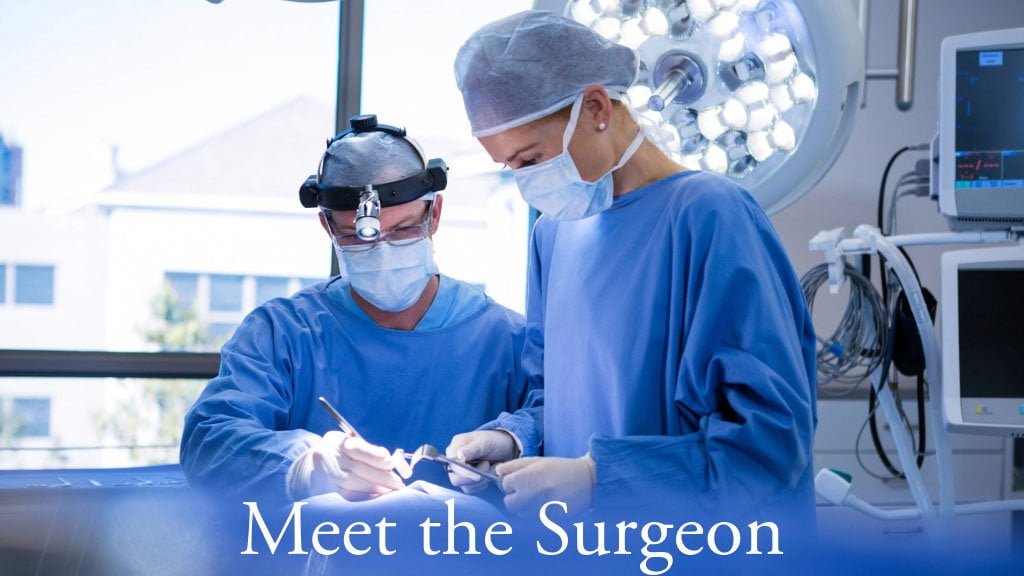Facelift
Facelift surgery tightens deep structures to restore a smooth jawline and oval contours of a youthful face.
In addition to natural skin wrinkles, aging results in loss of skin elasticity resulting in sagging eyebrows, drooping cheeks, and irregular neck contours. The oval face of youth sags with age and morphs into a square appearance. These visible signs of aging can be improved by tightening deeper facial structures, re-draping the skin of the face and neck, and removing selected areas of fat.
Facelift – The Essentials
During your consultation for face and neck lift, we will discuss techniques, possible complications, convalescence, and the expected outcome of the surgery.
Technique & Scars

A facelift is a cosmetic surgery procedure that rejuvenates the aging face by lifting and tightening sagging facial skin. The surgery combines skin excision and tightening of the underlying facial tissues to restore a smooth jawline and oval contours of a youthful face.
The lower facial component of a facelift is often referred to as a neck lift. A neck left addresses the aging jowls of the lower face and tightens the skin of the neck.
A facelift procedure is often combined with other rejuvenating surgeries such as blepharoplasties and lipofilling.
The MACS (Short Scars) facelift is the most popular procedure for rejuvenating the face and neck.
A “mini” facelift commonly refers to a facelift performed using a shortened incision. The resulting scar is short and does not extend to the hairline behind the ear. It is also known as a short scar facelift.
A popular short scar facelift is the MACS lift. Its official long name is Minimal Access Cranial Suspension. Short scar facelifts are best suited for patients with limited skin excess with mild to moderate signs of aging. Jowl and neck tightening are achieved by suture tightening the underlying support structures (SMAS) of the face. The scars are short.
A “mini” facelift limits the undermining of the skin to expose the SMAS. Limited facial dissection leads to fewer complications and faster recovery.
A short scar MACS facelift uses 3 support sutures to tighten the SMAS. More specifically, the technique places 3 non-absorbable sutures in the form of a loop within the SMAS. The first loop tightens the neck, a second the jowls, and the third loop the cheek prominence.
The skin is lifted in a vertical vector, avoiding skin redundancy in the neck. The result is a smooth neck and jawline without the need for a scar behind the ear.
The traditional facelift (known also as a cervicofacial lift,) places incisions in the scalp (at the temples and back of the neck) and around the ear. The skin is undermined to widely expose the SMAS for tightening. The traditional cervicofacial lift corrects sagging tissue of the cheeks, jowls, and contours neck. Excision of skin redundancy permits considerable tightening and reduction of wrinkles.
Compared to “mini” procedures, traditional facelift scars are more extensive but somewhat concealed by the scalp and shadows of the ear.
The lipo-lifting combines lipofilling with a facelift procedure. Lipofilling restores facial volume by transferring fat harvested from another part of the body. This technique is frequently used to correct what a facelift alone cannot treat: hollow gaze, hollow temples, flat cheekbones, and deep nasolabial folds.
Lipo-lifting permits greater finesse to tailor the rejuvenation procedure to achieve a youthful and natural facial appearance.
What a face and neck lift won’t do:
- It will not stop the aging process
- It will not treat the forehead, eyebrows, or midface
- Deep nasolabial folds are not corrected by a facelift
Facelifting will not address the above list of aging characteristics. Adjunctive combined procedures such as brow lift, blepharoplasty, and lipofilling can substantially enhance facial rejuvenation outcomes.
The duration effect following a facelift is highly variable. A facelift does not arrest the process of aging. With age, the effects of the facelift will gradually fade. Most patients will experience benefits for 5-10 years.
Skin protection and maintaining a stable body weight can influence the durability of a facelift. Avoidance of sun exposure, skin hydration, and stopping habits such as cigarette smoking will enhance the longevity of a facelift.
Botox and hyaluronic acid facial injections can serve as an adjunct to increase the longevity of a facelift procedure.
Facelift Considerations

If you wish to pursue surgery, routine laboratory tests are ordered to evaluate your fitness for general anesthesia and surgery.
Below is a basic checklist that Dr. Chen Lee uses:
- 1 month prior to surgery stop use of any tobacco or substances containing nicotine and do not resume until healed (usually 1 month after surgery)
- 1 month prior to surgery stop the use of all street drugs
- 2 weeks before surgery avoid the use of nonsteroidal anti-inflammatory medications (eg. Aspirin, Advil, Motrin, etc.)
- In the evening and morning before surgery, shower with an acne soap such as Spectro-Jel
- It is important to fast (not eat or drink anything) after midnight before surgery
You can reduce the risk of facelift complications by following your doctor’s instructions to prepare for surgery. A written detailed list of risks and complications will be provided. We encourage you to read it.
Every individual is unique. Each facelift is customized to the specific anatomy and expectations of the individual patient.
- Dr. Chen Lee’s patients usually have their facelift surgery performed under general anesthesia.
- The duration of surgery is 3-6 hours depending on the technique employed (“mini”, traditional, lipo-lift).
- 1-night admission to the surgery center is recommended.
Following a facelift, pain is typically mild and well managed with oral medication. However, you will experience a feeling of tightness from the suture suspension of the SMAS. It will not be comfortable to turn your head. This tight sensation will ease with the reduction of swelling and relaxation of tissues. These discomforts gradually improve 1-2 weeks after surgery.
Your face will be swollen for 1-2 weeks. You will also have bruises (blue) which will spontaneously subside in the first week.
Maintaining an extended neck posture in the first 2 weeks after surgery is important. The extended neck posture improves blood flow to the head and neck and reduces complications such as hematoma and skin compromise. Maintaining your chin in the air, avoiding lowering your chin, or bending your neck are methods to maintain neck extension. Furthermore, pillows are to be avoided when lying.
Busing and complications are diminished when you are nursed in a calm supportive environment. Head elevation and gentle movements will reduce surges of tension. This will protect the suspension of tissues and reduce the risk of hematoma.
Dr. Chen Lee recommends 4 weeks off of work to permit sufficient time to recover.
Hematoma is a risk with facelift surgery. This risk can be diminished preoperatively by avoiding nonsteroidal antiinflammatory medications and controlling blood pressure in hypertensive patients.
Skin compromise and necrosis are elevated in smokers. Ceasing the use of cigarettes 1 month before surgery will also diminish this risk.
Nerve injury is infrequent but possible due to its anatomical proximity to the SMAS.
Scars take an average of 6 months to 1 year to become less visible. Dark skin individuals are at risk of hypertrophic or keloid scars. Treatment with corticosteroid injections may be indicated.
Financing & Convalescence

If you are considering a facelift, the first step is to make an appointment for a consultation with Dr. Chen Lee.
During the consultation, your facial characteristics will be analyzed to determine the best lifting technique to address the specific aging aspects of your appearance.
Dr. Chen Lee will also inquire about:
- Your health
- Previous surgeries
- Medications
- Your expectations and desired outcome
The risks and complications associated with facelift surgery will be reviewed. Preparatory instructions will be provided. Photos will be used to illustrate possible outcomes and scars expected following facelift surgery.
The initial consultation lasts approximately 1 hour. During this visit, we will attempt to address concerns and answer all your questions. Several days after your consultation, interested patients will receive additional written information by email (consent form, preparatory instructions, information about the surgery center, price, and financing options).
The price of a facelift in Montreal is quoted as a “global fee”. The price quote includes the costs of the surgeon, anesthesiologist, nurses, office visits during the first postoperative year, operating room, and surgical facility fees. Revisions and touch-up surgeries are not included in the initial facelift quotation. If general anesthesia is necessary, you will have to pay for the substantial costs associated with a surgical revision. Minor touch-up surgery under local anesthesia can often be performed at minimal expense.
Facelift pricing is proportional to its complexity. The price range for an uncomplicated facelift is $16,000 – $21,000 + taxes. More accurate facelift pricing is possible only after a consultation with our plastic surgeon.
Our office requests payment in 2 equal installments. To reserve a date at the surgery center, we request an accompanying first installment (50% payment). The remaining balance is due 6 weeks before your scheduled date of surgery.
Surgeries are payable in cash, certified checks (bank drafts), or Interac. We also work with an independent credit company that offers financial payment plans for cosmetic surgery procedures. However, you should be aware that the interest rates and administration fees of this specialized company are higher than traditional financial institutions. It is often better to negotiate a loan through your personal bank or financial institution. We encourage you to do your homework and compare the true financial cost of these various financial options.
Healing is rarely painful. Most patients complain about tightness and difficulty in turning their heads. Swelling and bruising are expected. Many patients also complain of mild intensity headaches. These symptoms spontaneously resolve in 1-2 weeks. Rest, head elevation, and extended neck position assist in the resolution of symptoms following a facelift.
Dr. Chen Lee recommends you plan for a 4-6 week convalescent period. The scar will gradually fade over 6-12 months. At your 1-month follow-up visit, we recommend a topical silicone gel to improve scar quality.
Results are stable and readily apparent 3 months after facelift surgery.
FAQ – FACELIFT
Facelift procedures can be combined with other cosmetic surgeries. You can resume your normal activities (with certain restrictions) after 2 weeks. Our procedures for a facelift in Montreal are generally performed under general anesthesia. We also recommend an overnight observation at the surgery center.
It is normal to have many questions. Below are some of the most frequent questions asked about facelifts that may help you decide whether the procedure is right for you.
Candidates must also be in good health, have no serious or active illnesses, no pre-existing medical conditions, and should have reasonable expectations of what can be achieved by surgery. If you plan to lose a significant amount of weight, you should discuss these plans with the doctor before surgery.
The duration effect following a facelift is highly variable. A facelift will not stop the aging process. With age, the effects of the facelift will gradually fade. Most patients will experience benefits for 5-10 years.
Skin protection and maintaining a stable body weight can influence the durability of a facelift. Avoidance of sun exposure, skin hydration, and stopping habits such as cigarette smoking will enhance the longevity of a facelift.
Below is a basic checklist that Dr. Chen Lee uses:
- 1 month prior to surgery stop use of any tobacco or substances containing nicotine and do not resume until healed (usually 1 month after surgery)
- 1 month prior to surgery stop the use of all street drugs
- 2 weeks before surgery avoid the use of nonsteroidal anti-inflammatory medications (eg. Aspirin, Advil, Motrin, etc.)
- In the evening and morning before surgery, shower with an acne soap such as Spectro-Jel
- It is important to fast (not eat or drink anything) after midnight before surgery
The duration of time is proportional to the complexity of the specific case. Typical simple MACS facelift techniques require 4 hours of surgical time. More complex combined procedures may require 8 hours.
The “mini” facelift technique can be performed on ambulatory outpatients. However, patients having more complex combined facelift surgeries are best managed with overnight observation at the surgery center.
Topical creams are not effective. Minor improvements might be possible with facial injectables. Facelifting procedures offer more substantial and longer-lasting changes. A facelift can tighten the muscles, skin, and subcutaneous tissue to make you look younger and fresher. Do not hesitate to make an appointment to learn about the different types of facelifts and your options.
Smokers are at greater risk of complications. Especially that of skin necrosis and poor healing. This may lead to prolonged recovery periods and poor scarring. Every attempt should be made to stop cigarette smoking 1 month before a planned facelift.
Low impact activities such as brisk walks, stationary cycling, and training on an elliptical exercise machine can be resumed 3 weeks after an uncomplicated facelift. High impact activities such as running and high-intensity fitness classes can resume 6 weeks after surgery. Contact sports that involve the risk of skin trauma (i.e. martial arts) should be suspended for a minimum of 3 months.
Facelift surgery seldom causes pain. However, most patients complain about an unpleasant sensation of tightness and difficulty in turning their heads. Swelling and bruising are expected. Many patients also complain of mild intensity headaches. These symptoms spontaneously resolve in 1-2 weeks. Rest, head elevation, and extended neck position assist in the resolution of symptoms following a facelift.

